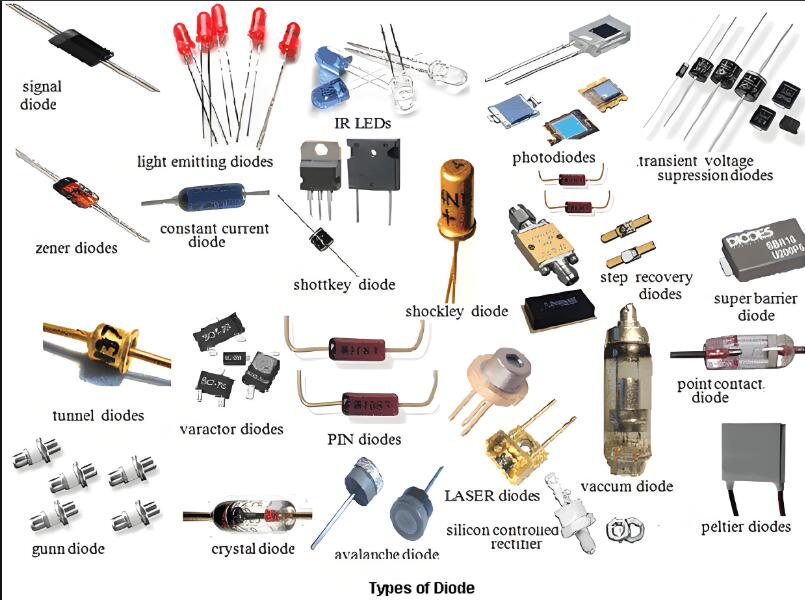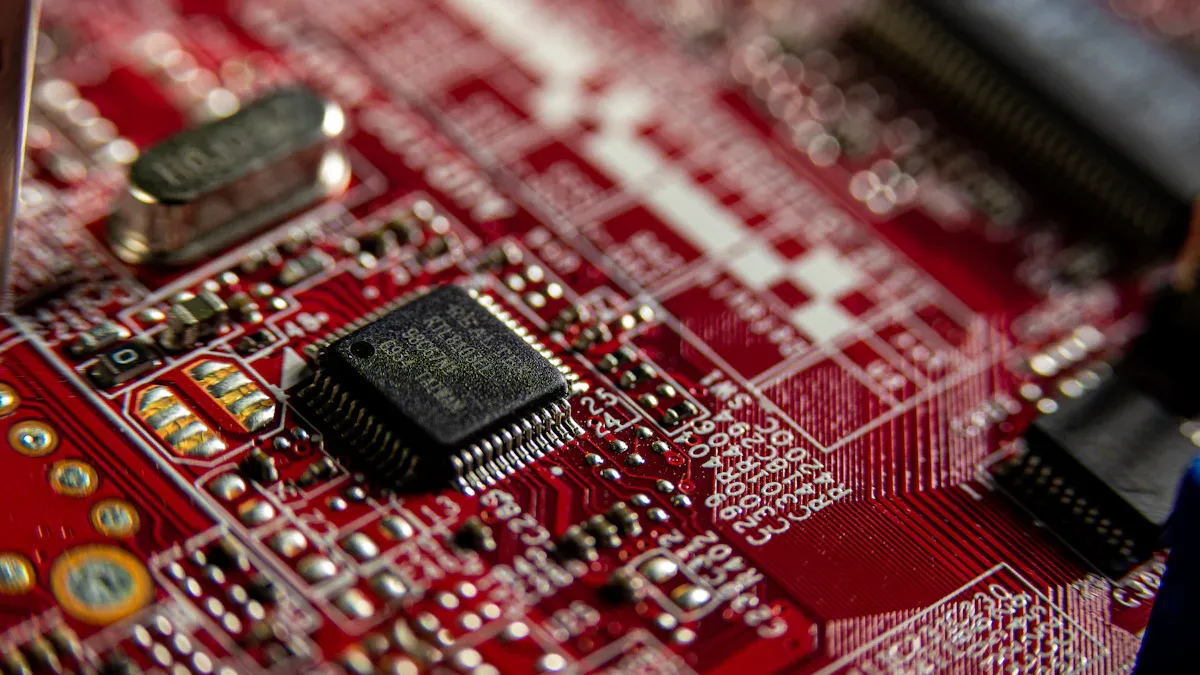How to use the BAT54SLT1G diode in digital logic circuits

The BAT54SLT1G plays a crucial role in digital logic circuits by enhancing performance and ensuring protection. Its fast recovery time of 5 nanoseconds makes it an excellent choice for high-speed switching applications. This diode minimizes power loss with a forward voltage drop of only 800 millivolts, ensuring efficient operation. Additionally, its 200mA average rectified current rating enables it to handle significant current loads. These features allow the BAT54SLT1G to clamp voltage spikes, protect sensitive components, and maintain circuit reliability. Its versatility makes it a popular choice among Discrete Semiconductor Products,Diodes distributor networks.
Key Takeaways
The BAT54SLT1G diode has a low voltage drop of 0.35 volts, making circuits work better.
It switches quickly in just 5 nanoseconds, great for fast tasks.
This diode keeps parts safe by stopping sudden voltage jumps, helping circuits work well.
Its small SOT-23 size fits easily in tight spaces, good for small gadgets.
Testing and installing the BAT54SLT1G correctly can stop problems and make it last longer.
Key Features of the BAT54SLT1G
Low forward voltage drop and fast switching
The BAT54SLT1G excels in applications requiring rapid switching and minimal power loss. Its forward voltage drop is typically 0.35 volts at a current of 10 mA, ensuring efficient operation in digital circuits. The diode also features a fast recovery time of just 5 nanoseconds, making it ideal for high-speed switching tasks. These characteristics allow it to handle dynamic signal processing with precision.
Key performance metrics include:
Forward Voltage Drop: 0.35 Volts (Typical) at IF = 10 mAdc
This combination of low forward voltage and fast switching enhances the performance of digital logic circuits, ensuring reliable operation even in demanding environments.
Compact SOT-23 surface-mount package
The BAT54SLT1G is housed in a compact SOT-23 surface-mount package, making it suitable for space-constrained designs. This package allows engineers to optimize board layouts for portable devices and handheld electronics. Its small footprint simplifies integration into modern circuit designs, where space efficiency is critical.
The diode's technical specifications further validate its suitability for compact applications:
Specification | Value |
|---|---|
Operating Temperature Range | -55°C to 125°C |
Max Surge Current | 600mA |
Average Rectified Current | 200mA DC |
Forward Voltage | 800mV |
Max Reverse Voltage (DC) | 30V |
Reverse Recovery Time | 5 ns |
This compact design ensures the BAT54SLT1G can be used in portable devices without compromising performance.
High reliability and efficiency in digital circuits
The BAT54SLT1G offers high reliability and efficiency, making it a trusted choice for digital logic circuits. Its robust design ensures consistent performance across a wide operating temperature range, from -55°C to 125°C. The diode's low reverse leakage current, typically 2 μA at 25 volts, minimizes energy loss, contributing to overall circuit efficiency.
Engineers rely on the BAT54SLT1G for its ability to handle repetitive reverse voltages up to 30 volts and peak surge currents of 600 mA. These features make it suitable for applications requiring durability and long-term reliability.
The diode's efficiency and reliability enable it to protect sensitive components, clamp voltage spikes, and maintain stable circuit operation, even under challenging conditions.
Applications of the BAT54SLT1G in Digital Logic Circuits
Voltage clamping to protect sensitive components
The BAT54SLT1G plays a vital role in voltage clamping applications. It prevents voltage spikes from damaging sensitive components in digital logic circuits. When a transient voltage exceeds the safe operating range, the diode redirects the excess energy away from critical parts of the circuit. This process safeguards microcontrollers, integrated circuits, and other delicate components.
Engineers often use the BAT54SLT1G in circuits prone to sudden voltage fluctuations. Its low forward voltage drop ensures efficient energy redirection without significant power loss. The diode's fast switching speed further enhances its ability to respond to rapid changes in voltage.
Tip: Place the BAT54SLT1G close to the component it protects to minimize the risk of damage from transient voltages.
Signal rectification in digital systems
Signal rectification is another common application of the BAT54SLT1G. In digital systems, the diode converts alternating current (AC) signals into direct current (DC). This process ensures that the circuit receives a stable and consistent power supply.
The BAT54SLT1G's low forward voltage drop makes it ideal for rectification tasks. It minimizes energy loss during the conversion process, improving the overall efficiency of the circuit. Its compact SOT-23 package allows easy integration into space-constrained designs, such as portable devices and embedded systems.
Engineers use the BAT54SLT1G in signal processing circuits to maintain the integrity of digital signals. Its fast recovery time ensures accurate rectification, even in high-speed applications.
Reverse current protection in logic circuits
Reverse current protection is essential for maintaining the reliability of digital logic circuits. The BAT54SLT1G prevents current from flowing in the wrong direction, which could damage components or disrupt circuit operation.
When reverse voltage occurs, the diode blocks the current flow, protecting the circuit from harm. Its low reverse leakage current ensures minimal energy loss during this process. The BAT54SLT1G's ability to handle repetitive reverse voltages up to 30 volts makes it suitable for demanding applications.
Note: Use the BAT54SLT1G in circuits with power sources prone to polarity reversal to ensure consistent operation and protection.
How to Integrate the BAT54SLT1G into Digital Logic Circuits

Selecting the BAT54SLT1G for your design
Choosing the right diode for a digital logic circuit involves evaluating the circuit's requirements. The BAT54SLT1G is ideal for applications needing fast switching, low forward voltage drop, and compact packaging. Engineers should consider the diode's maximum reverse voltage of 30 volts and its average rectified current of 200 mA. These specifications ensure compatibility with most digital circuits.
When selecting the BAT54SLT1G, it is essential to verify the operating temperature range of -55°C to 125°C. This range ensures reliable performance in various environments. Additionally, its SOT-23 surface-mount package makes it suitable for space-constrained designs.
Tip: Use the BAT54SLT1G in circuits where efficiency and reliability are critical, such as portable devices or high-speed switching systems.
Designing a circuit with the BAT54SLT1G
Incorporating the BAT54SLT1G into a circuit requires careful planning. Start by identifying the diode's role, such as voltage clamping, signal rectification, or reverse current protection. Place the diode close to the component it protects to minimize voltage spikes.
For example, in a voltage clamping circuit, connect the BAT54SLT1G in parallel with the sensitive component. Ensure the cathode faces the positive voltage source. This configuration allows the diode to redirect excess voltage safely.
Use proper soldering techniques when mounting the SOT-23 package. Avoid overheating the diode during installation to maintain its performance.
Testing and verifying the circuit functionality
After assembling the circuit, testing ensures the BAT54SLT1G performs as expected. Use a multimeter to measure the forward voltage drop and verify it matches the typical value of 0.35 volts at 10 mA. Check the reverse leakage current to confirm it remains within acceptable limits.
Simulate voltage spikes to test the diode's clamping ability. Observe whether the BAT54SLT1G redirects excess voltage without damaging other components. For circuits involving signal rectification, measure the output to ensure proper AC-to-DC conversion.
Note: Regular testing helps identify potential issues early, ensuring the circuit operates reliably over time.
Best Practices for Using the BAT54SLT1G
Proper handling and placement in circuits
Proper handling of the BAT54SLT1G ensures its longevity and performance. Engineers should avoid exposing the diode to excessive heat during soldering. Using a temperature-controlled soldering iron helps prevent thermal damage. Additionally, anti-static precautions, such as wearing an ESD wrist strap, protect the diode from electrostatic discharge.
Placement within the circuit also plays a critical role. The diode should be positioned close to the component it protects. This minimizes the length of the conductive path, reducing the risk of voltage spikes. For reverse current protection, the BAT54SLT1G must be oriented correctly, with the cathode facing the positive voltage source.
Tip: Use a magnifying tool to inspect solder joints for proper connections and avoid cold soldering.
Avoiding common mistakes during installation
Several common mistakes can compromise the performance of the BAT54SLT1G. Incorrect polarity is a frequent issue. Engineers should double-check the orientation of the diode before soldering. Misalignment of the SOT-23 package can also lead to poor connections. Using a PCB layout guide ensures accurate placement.
Overheating during installation is another common error. Excessive heat can degrade the diode's internal structure. To avoid this, limit soldering time to a few seconds per joint. Lastly, neglecting to clean flux residue can cause corrosion over time. Cleaning the PCB with isopropyl alcohol ensures a reliable connection.
Note: Always verify the diode's orientation and connections before powering the circuit.
Troubleshooting issues with the BAT54SLT1G
When issues arise, systematic troubleshooting can identify the root cause. Start by checking the diode's orientation. A reversed BAT54SLT1G will not function as intended. Next, measure the forward voltage drop using a multimeter. A reading significantly different from 0.35 volts may indicate a damaged diode.
Inspect the solder joints for cracks or cold soldering. Reflowing the solder can often resolve connectivity issues. If the circuit experiences unexpected voltage spikes, verify the diode's placement relative to the protected component. Adjusting the layout may improve performance.
Tip: Replace the diode if it shows signs of physical damage or fails basic electrical tests.
The BAT54SLT1G diode offers exceptional features like low forward voltage drop, fast switching, and high reliability. Its compact SOT-23 package makes it ideal for space-constrained designs. Engineers use it for voltage clamping, signal rectification, and reverse current protection in digital logic circuits.
Tip: Experimenting with the BAT54SLT1G in projects helps engineers understand its versatility and performance.
Understanding the diode's role in circuit design ensures efficient and reliable operation. By mastering its integration, engineers can create robust and innovative digital systems.
What makes the BAT54SLT1G ideal for high-speed switching?
The BAT54SLT1G features a reverse recovery time of 5 nanoseconds. This allows it to switch rapidly between states, making it suitable for applications requiring quick signal transitions. Its low forward voltage drop also minimizes energy loss during switching.
How can the BAT54SLT1G protect sensitive components?
The diode clamps voltage spikes by redirecting excess energy away from critical components. Its fast switching speed ensures immediate response to transients, while its low forward voltage drop enhances efficiency during protection.
Can the BAT54SLT1G be used in portable devices?
Yes, the BAT54SLT1G’s compact SOT-23 surface-mount package makes it ideal for space-constrained designs. Its low power consumption and high reliability further support its use in portable and handheld electronics.
What is the correct orientation for the BAT54SLT1G in reverse current protection?
For reverse current protection, the cathode must face the positive voltage source. This orientation blocks current flow in the wrong direction, ensuring circuit reliability and preventing damage.
How should engineers test the BAT54SLT1G after installation?
Engineers can use a multimeter to measure the forward voltage drop, which should match the typical value of 0.35 volts at 10 mA. Simulating voltage spikes verifies its clamping ability, while signal rectification tests ensure proper AC-to-DC conversion.
See Also
Enhancing Process Control with AD74413RBCPZ Insights
Three Key Benefits of ATIC83E2 in Automation
Comprehensive Guide to Using AD620AN in TVs
Transform Your Projects with EP2C50F484I8N FPGA Insights
Understanding MC9S12DJ256MFUE Specifications for Automotive Use
CALL US DIRECTLY
(+86)755-82724686
RM2508,BlockA,JiaheHuaqiangBuilding,ShenNanMiddleRd,Futian District,Shenzhen,518031,CN
www.keepboomingtech.com sales@keepboomingtech.com
